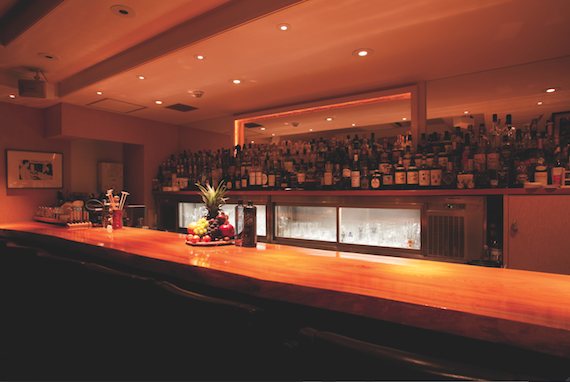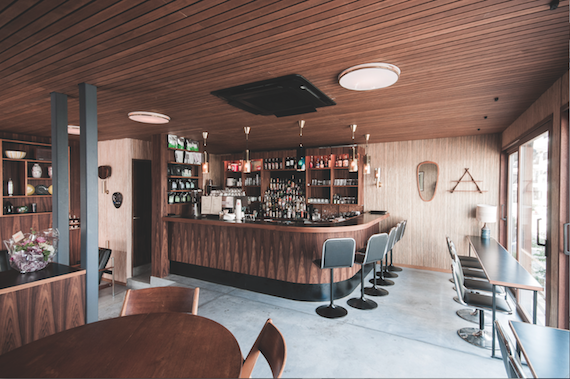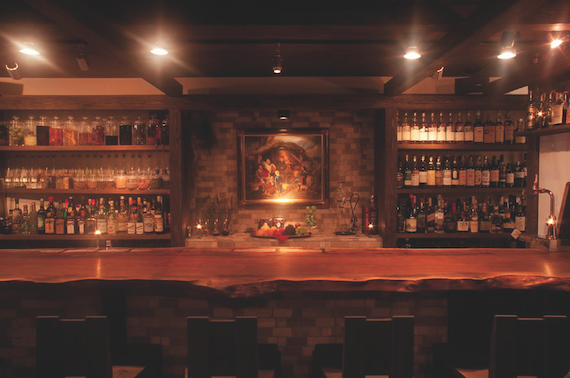
City Guide to Tokyo
Nicolas Coldicott takes a look at a new generation of bars
You know the cliche: the Japanese bartender with his Brylcreemed hair, talking about how cold or pure his ice is. He’ll hard-shake you a gimlet in 20 minutes and it will be sublime. Ask for something more creative and he’ll switch the Beefeater for Tanqueray.
There’s a truth behind that cliche, of course. Tokyo is a city of technical masters who don’t fix what ain’t broke. But times they are a-slightly changing, and international ideas that once struggled to cross the Pacific are now reaching Tokyo’s bartenders. You’ll still find the Savoy Cocktail Book in almost every bar, but you might also find something by Jim Meehan, David Kaplan or Tony Conigliaro, At least two of the bars in our top 10 offer drinks flavoured with Japanese cypress – a wood more traditionally used to make bath tubs.
A decade ago, a tour of the top 10 Tokyo bars wouldn’t have strayed from the streets of Ginza. That area is still home to the most exclusive establishments, and with around 800 to choose from, it’s still where any sensible cocktail aficionado should begin. But these days there are landmark bars all over the capital. The young generation of bartenders seems more interested in prestige spirits than prestige addresses.
And the best news of all for the visiting bar-hopper: the new wave are much more likely to speak English.
Star Bar, 1-5-13 Ginza, Chuo-ku

Hisashi Kishi is to cocktails what Jiro Ono is to sushi. Both are masters of their craft who take simple ingredients and work culinary magic.
So it’s fitting that the government marked Culture Day this year by handing them both medals of honour. Kishi isn’t short of accolades. He’s won the IBA world championship, multiple national trophies, and became chairman of Japan’s Bartenders’ Association before he turned 50.
He’s known for simple, often classic cocktails — his Sidecar is a local legend — but the simplicity is deceptive. For each drink he makes, Kishi has analysed how large his ice should be, how long he should shake or stir, which motion to use, and even which material his shaker should be… some drinks call for a steel shaker, others demand plastic. He’s also one of the few bartenders to fret about the size of bubbles in a cocktail, and how it affects the flavour. Few bartenders take technique quite so seriously.
Bar High Five, 4F, 7-2-14 Ginza, Chuo-ku

He’s the man who carves ice into diamonds, and the face of a thousand cocktail juries, but when he’s on home turf Hidetsugu Ueno operates out of a surprisingly humble space in a building crammed with bars of all descriptions.
The dimensions work to his advantage, allowing him to get to know his guests, figure out their tastes and serve them drinks they never knew they wanted.
Ueno has also phased out much of his scotch collection in favour of Japanese whisky, and has a repertoire of cocktails that use the local spirits. He’s been instrumental in spreading the word (and dispelling the myths) about Japanese bartending and, as a Ginza-trained bartender with a detailed knowledge of the global bar scene, he’s the perfect bridge between east and west.
And that gulf between the size of Ueno’s reputation and the size of his bar mean it’s a very good idea to call ahead and check there’s space.
Trench, 1-5-8 Ebisu Nishi, Shibuya-ku
Historical cocktails, classics with a twist, bitters galore, faux vintage menus… Trench is an American-style cocktail bar in every sense but its size. It’s a sliver of a room, taller than it is wide, and that’s part of the appeal. You don’t want to be too far from the counter where polyglot bartender Rogerio Igarashi Vaz holds court. Trench pitches itself as an absinthe specialist, and there’s certainly more of La Fée Verte than anyone could possibly need, but that’s not why this tiny spot has elbowed its way on to Tokyo’s must-visit list.
The drinks are just the right amount of creative, with a menu that changes each season, and Vaz has an instinct for hospitality that means you’ll be as comfortable here on a date as you would be if you came solo or with friends. Once in a while a band plays on what can only be described as a shelf above the bar.
Bar Orchard, 7F, 6-5-16 Ginza, Chuo-ku

At first glance Bar Orchard is quintessential Ginza. The zelkova counter, twinkling jazz and glassware in refrigerated cabinet all suggest you’re in for a night of straight-up classics. But there’s something different happening here. Bartender Takuo Miyanohara, wearing what looks like a butcher’s apron, might make you that classic, or he might reach for the liquid nitrogen, or fire up his bubble machine.
Ask for a Manhattan and you’ll suspect something got lost in translation when he crumbles cinnamon and orange peel into a glass, then grabs a red wine, some Pernod and caramel syrup. But when
he’s finished, and you take a sip, you realise he’s been building a mock vermouth.
You can have a Moscow Mule the orthodox way, or one made from vodka infused with ginger, topped with soda and garnished with powdered ginseng.
His ability to switch effortlessly between traditional and experimental helps to explain why you’ll see 20-somethings, septuagenarians, and everyone in between sitting at the counter.
Mixology Laboratory, 3F, 1-6-1 Yaesu, Chuo-ku

‘Mixology’ is a dirty word in most of Tokyo’s bars, but Shuzo Nagumo has embraced the idea wholeheartedly. In fact, he’s embraced just about every modern bar trope that makes the classicists squirm: his bar is styled on a speakeasy, he barrel-ages, roto-vaps and aromatises, and he uses ingredients as off-the-wall as grilled asparagus, grilled miso, and foie gras in his cocktails.
Ignore the two wooden decoy doors and choose the almost imperceptible black door. Tap the secret code (it’s 0715*) into the security panel, and the door will spring open. Inside, it’s a throwback to the 1920s stylistically, though nobody back then was drinking wasabi-flavoured gin and tonic.
There are no fewer than four styles of blue cheese martini. And if you order a terroir cocktail, it will come with an air bag filled with the scent of soil.
Gimmicks? Yes. But they’re bloody good
Gen Yamamoto, 1-6-4 Azabu Juban, Minato-ku
Bartender Gen Yamamoto upends everything you thought you knew about mixing drinks.
He never shakes a cocktail, or stirs with ice. He doesn’t believe his drinks need to be ice-cold or thoroughly blended. And though there is a tiny a la carte menu, the smart customers opt for his tasting flights, where he chooses what you’ll drink.
Yamamoto serves four or six courses of small but powerfully flavoured cocktails.
The recipes appear stunningly simple, though in truth there’s plenty of preparation making compotes and reductions to get this intensity of flavour. He likes to use Japanese ingredients.
Sake or shochu underpins many of his creations, and obscure local citrus fruits make frequent appearances. Yamamoto operates alone in a hushed Japanese-style room dominated by a giant slice of oak that serves as the bar counter. There’s nowhere else remotely like it.
Bar Dice, B1, 6-9-13 Ginza, Chuo-ku

Bartender Daisuke Fujita was thinking of his visits to Piedmont when he asked a design firm to build him something resembling the drawing room of an old Italian villa.
The walls are clad in stone, leather armchairs sit beside a mock fireplace, and a huge iron oven has been repurposed as a liquor shelf.
The counter is a 400-year-old slice of poplar imported from Bordeaux. With baroque music on the stereo, it’s hard to imagine you’re in a city-centre basement.
Fujita took those trips to Piedmont to indulge his love of grappa. He’s amassed around 100 bottles of the stuff, and every single one of them comes from the estate of the late, great Romano Levi. His cocktails are classics with a twist.
A spring feeling might come with yuzu instead of lemon, for example. And he likes to blend spirits and
liqueurs from different makers and different eras to give familiar drinks an unexpected depth.
Bar Mimitsuka, B2F, 6-6-19 Ginza, Chuo-ku
The decor could be described as minimalist but for the enormous Japanese flag, heavily graffitied with marker pen messages, covering the far wall.
It’s a souvenir of bartender Fumiyasu Mimitsuka’s appearance at the International Bartenders’ Asssociation world finals in 2012 (he came home with two trophies – best technical and best after-dinner drink) and it attests to both his skill and his popularity. He rose to prominence as head bartender of Little Smith, a much-loved, modern-looking but classic-thinking bar in Ginza.
After winning the Japanese Bartenders’ Association competition, and dazzling
at the global finals, Mimitsuka opened his eponymous bar in a Ginza basement this year.
Service begins with a cup of consommé, then on to the cocktails. There’s no menu, but you won’t need one.
The bartender will guide you through a series of masterfully balanced drinks. They could be ornate, like his trophy-winning creations, or they might be stunningly simple, like his revelatory R&B (just rum and Benedictine).
Fuglen Tokyo, 1-16-11 Tomigaya, Shibuya-ku

When the owners of Oslo’s fashionable bar cafe Fuglen decided to open a second branch, they picked a location 8,400km away in Tokyo. They opened in spring 2012, and stuck closely to the template of their original location – cafe by day, cocktail bar by night, in a room furnished handsomely in mid-20th century Scandinavian design classics, all of which you can buy from them.
There’s a permanent menu of classic cocktails and a seasonal menu that often showcases Japanese ingredients in ways you would never dream of.
Oslo-based head bartender Halvor Digernes flies in each season to overhaul the menu. It’s a casual space — you can bring your own food — that attracts the laptop set, local residents and every visiting Scandinavian. If you’re there in the daytime, the coffee, roasted by the Fuglen team just around the corner, is superb.
Ben Fiddich, 9F, 1-2-3-7 Nashi Shiniuku-ku

If you want to know how unusual a bartender Hiroyasu Kayama is, consider this – he’s got a cage with bottles of Ardbeg 10 Years Old sitting in a pond in Saitama Prefecture to see how it affects the flavour. While we wait a year for the results of that experiment, we can try his absinthe, distilled in the bar from home-grown wormwood, or sample a cypress-infused vodka tonic, or one of his Mojitos that’s so packed with herbs you could sit and smell it all night. He’ll make you a root beer by grinding the botanicals in a mortar, adding it to a plastic bottle of soda, then blasting it with gas. Kayama seems to have a limitless appetite to make simple drinks the hardest, freshest way possible, and it’s part of what makes the year-old Ben Fiddich one of the most exciting bars on the Tokyo drink scene right now.
